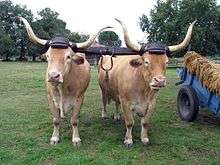Béarnaise (cattle)
 Yoked pair of oxen at the Écomusée de la Grande Lande at Marquèze | |
| Conservation status | FAO (2007): critical-maintained[1]:41 |
|---|---|
| Other names | |
| Country of origin | France |
| Distribution | Aquitaine |
| Use | meat |
| Traits | |
| Weight | Male: 900 kg[2] |
| Female: 600 kg[2] | |
| Height | Female: 135 cm[2] |
| Skin color | white |
| Coat | wheaten |
| Horn status | horned in both sexes |
|
Cattle Bos (primigenius) taurus | |
The Béarnaise is a French breed of domestic beef cattle. It originates in the area of the traditional province of Béarn, in the east of the département of Pyrénées-Atlantiques, in the northern Pyrénées in south-west France. It was merged with other breeds in 1920 to form the Blonde des Pyrénées, which in turn was fused with the Blonde de Quercy and Garonnaise breeds to create the Blonde d'Aquitaine in 1962.
History
The Béarnaise originated in the area of the traditional province of Béarn, in the east of the département of Pyrénées-Atlantiques, in the northern Pyrénées in south-western France. It was a triple-purpose breed, kept for its meat, for its milk, and as a draught animal. A herd-book was established in 1900.[2]
The Béarnaise was merged with several other local blonde breeds, including the extinct Basquiaise and Race d'Urt, to create the Blonde des Pyrénées (Spanish: Rubia de los Pirineos), for which the herd-book was started in 1920.[3]:125[4]:207 The Blonde des Pyrénées was in turn merged with the Blonde de Quercy and Garonnaise breeds to create the Blonde d'Aquitaine in 1962.
A small number of the original type of the Béarnaise survived in the Vallée d'Aspe, and from these the breed was re-constituted. A herd-book was begun in 1982,[5] and a breeders' association was formed in 2003.[3]:125
The conservation status of the Béarnaise was listed by the FAO as "critical-maintained" in 2007.[1]:41 In 2010, 56 owners had a total of 223 cows.[3]:125 In 2014 the population was reported at 324 head.[5]
Characteristics
The Béarnaise is wheat-coloured, varying from a dark fawn to white.[3]:125 It is heavily dewlapped, with long lyre-shaped horns.[2] The skin and mucous membranes are pale, the surround of the eye phaeomelanic.[2]
It is well adapted to draught work and to the mountain environment of the Pyrénées.[2][5]
Use
The Béarnaise was formerly a triple-purpose breed, kept for milk, for meat and for draught work. It was traditionally milked for only about six months; the milk was used to make mixed cows'-milk/sheep's-milk cheeses.[3]:125 Milk production is low, approximately 2000 l in a lactation of 200 days.[2]
References
- 1 2 Barbara Rischkowsky, D. Pilling (eds.) (2007). List of breeds documented in the Global Databank for Animal Genetic Resources, annex to The State of the World’s Animal Genetic Resources for Food and Agriculture. Rome: Food and Agriculture Organization of the United Nations. ISBN 9789251057629. Accessed November 2016.
- 1 2 3 4 5 6 7 8 Étude de la race bovine: Béarnaise (in French). Bureau des Ressources Génétiques. Archived 7 March 2009.
- 1 2 3 4 5 Valerie Porter, Lawrence Alderson, Stephen J.G. Hall, D. Phillip Sponenberg (2016). Mason's World Encyclopedia of Livestock Breeds and Breeding (sixth edition). Wallingford: CABI. ISBN 9781780647944.
- ↑ Marie Dervillé, Stéphane Patin, Laurent Avon (2009). Races bovines de France: origine, standard, sélection (in French). Paris: Éditions France Agricole. ISBN 9782855571515.
- 1 2 3 Breed data sheet: Béarnaise/France. Domestic Animal Diversity Information System of the Food and Agriculture Organization of the United Nations. Accessed November 2016.
![]() Media related to Béarnaise at Wikimedia Commons
Media related to Béarnaise at Wikimedia Commons